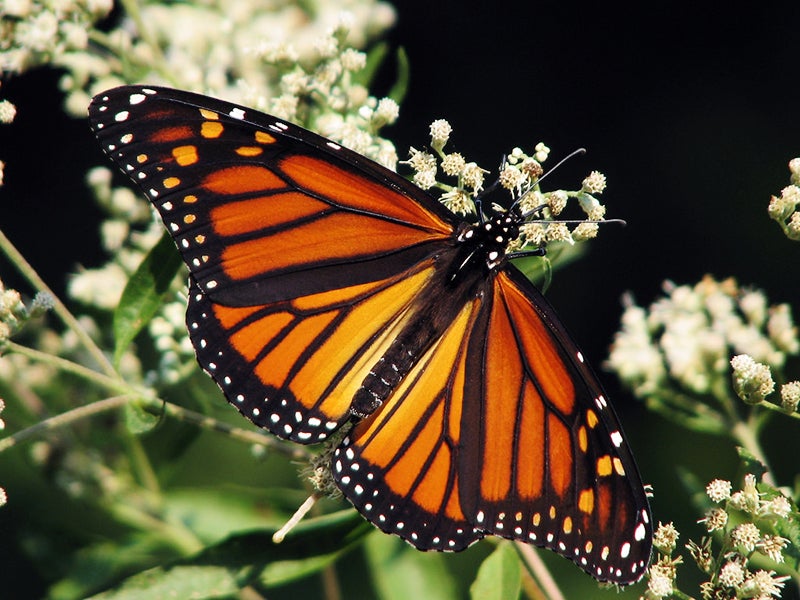Come Snow and Drought, Monarch Butterflies Fly On
Monarch butterfly numbers have rebounded miraculously this year, leaving scientists and butterfly admirers alike wondering if it’s just a fluke or if the monarchs are adapting to their historic route’s changing landscape.

This page was published 8 years ago. Find the latest on Earthjustice’s work.
As we celebrate the first weeks of spring, monarch butterflies consider their long flight home. Every March, these tiny fliers embark on a 2,000-mile return trip north to the U.S. and Canada after spending the winter in the temperate forests of central Mexico. Over the past 10 years, the area monarch butterflies cover in their winter refuge in Mexico has dropped by 59 percent. But this year butterfly numbers rebounded miraculously, leaving scientists and butterfly admirers alike wondering if the monarchs are managing to adapt to their route’s changing landscape.
The monarch butterfly’s consistent flight path makes the species a strong indicator of the effects of erratic climate events and land degradation within its range. The years-long drought in the western U.S. has led to a decline in milkweed—a plant the butterflies depend on for food and laying their eggs—as well as warmer temperatures that fail to spur migration. The monarchs that successfully make it to their winter resting grounds, the Monarch Butterfly Biosphere Reserve in Michoacán, Mexico, encounter disturbed habitat there as well. Unusual icy storms in central Mexico’s fir forests have caused huge numbers of butterflies to freeze to death in recent years. If that weren’t bad enough, the reserve has been subject to an increase in illegal logging, despite its protection as a World Heritage Site.
This makes the fact that in December 2015 the number of successful migrators rebounded was nothing short of incredible. However, while many jumped to the hopeful conclusion that the monarch population was making a comeback, others were more skeptical. In a recent study, scientists pioneered a new approach to assessing how vulnerable the species is to extinction and the right target number for recovering the species. They found that there is an 11 to 57 percent risk of the primary migrating population going extinct in the next 20 years. The study results suggest that annual population counts may not accurately reflect the species’ ability to rebound from large die-offs, and also that current efforts to save the monarchs may not be enough.
Reducing herbicide use, another driver of milkweed scarcity, is essential to the restoration of the monarch’s habitat—especially their primary summer mating grounds in the Midwest. For years, the most popular herbicide on the market has been Monsanto’s “Roundup,” which is used on crops that are genetically modified to resist its primary ingredient, glyphosate.
In 2012, U.S. growers sprayed 280 million pounds of glyphosate, decimating native milkweed on agricultural land and increasing the prevalence of glyphosate-resistant weeds. Rather than reduce herbicide use, the chemical company Dow decided to combat the glyphosate-resistance problem by introducing Enlist Duo, a toxic combination of glyphosate and 2,4-D that’s designed to kill weeds that have developed resistance to glyphosate. If 2,4-D sounds familiar, that’s because it was infamously used during the Vietnam War as an active ingredient in Agent Orange. Earthjustice represented a coalition of conservation groups in challenging the EPA’s approval of “Enlist Duo,” urging the agency to take the lethal cocktail off the market immediately. Meanwhile, Monsanto is seeking EPA’s approval of its competitor to Enlist Duo, a mixture of glyphosate and the herbicide dicamba to be marketed as the “Extend” crop system. Earthjustice is closely monitoring this as well.
In addition to taking action against harmful pesticides and herbicides, a variety of other efforts have sprung up in recent years to protect this little orange and black wonder, which can fly up to 25 miles per hour. Backyard gardeners, activists and school groups have spearheaded a movement to plant native milkweed species along the butterflies’ migration route. Moreover, the Mexican government’s environmental protection agency, Profepa, is giving funds to the largely indigenous nearby farm communities in exchange for preserving the Michoacán reserve. In the U.S., the Fish and Wildlife service has pledged $3.2 million to support monarch conservation. The Center for Biological Diversity and the Center for Food Safety are pushing the Fish and Wildlife Service to protect monarchs under the Endangered Species Act. Adding monarchs to the Endangered Species List would lead to the development of a recovery program with federal funding. It would also require that use of herbicides like glyphosate that could impair the monarch’s survival or recovery would have to be evaluated under the ESA.
A remarkable biological event like the monarch migration offers a rare opportunity to measure the effects of human disturbance, as well as Mother Nature’s tremendous resilience. Their migratory behavior depends on the climate and terrain of a landscape that is rapidly changing—and yet they seem to be bouncing back. Whether they can overcome and adapt in the long run will depend on courageous conservation efforts, as well as legislation that rejects the introduction of increasingly toxic chemicals into the environment.
A graduate of Wesleyan University with an honors degree in English and environmental studies, Anna was an intern at Earthjustice in San Francisco. She previously interned at Women’s Earth Alliance, and managed a half-acre garden and orchard growing produce for a Community Supported Agriculture program.
